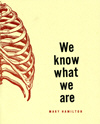We Know What We Are
Winner of the Rose Metal Fourth Annual Short Short Chapbook Contest, We Know What We Are is packed full of thirteen micro-fictions. Sometimes stories, sometimes beautiful word play, this collection is a stunning amalgam of brevity and depth.
Winner of the Rose Metal Fourth Annual Short Short Chapbook Contest, We Know What We Are is packed full of thirteen micro-fictions. Sometimes stories, sometimes beautiful word play, this collection is a stunning amalgam of brevity and depth.
Language—elegant but never distancing diction—lies at the heart of each piece. Hamilton makes every sentence compelling, even when the ultimate meaning is hard to pin down: “In a past life I was a streetlight. In a past life I lost my hand in a bet. I was a long stretch of road.” These lines, like so many in this chapbook, are suggestive and intriguing; they possess, as Dinty W. Moore notes in the introduction, “a stark urgency.” Even when story was elusive, lines such as these kept me reading, sparking ideas and associations.
As I read, lines kept stopping me short, as in the piece “Hey There Stranger, Come On Over and Hold My Hand,” which is mostly a sequence of “I am” statements. Instead of becoming repetitive, each sentence opens up new possibilities: “I am the missed belt loop”; “I am your director’s chair with your name on the back.” There’s nothing tricky about this writing, yet it is stunning and fresh.
Perhaps I am biased towards an old-fashioned narrative line, but my favorite piece in this chapbook is “We Know What We Are.” This story traces out the life of conjoined twins, Janna and the first person narrator, who experience Halloween as the one day when they aren’t treated as freaks, when, as one twin says, there is “no one punching me in the face to see if Janna could feel it.” My second favorite was the other (mostly) traditional narrative: “Me and Theodore Dress Up Like Eskimos While We Roast Chestnuts on a Hotplate.” But even in these pieces with plot, the quirkiness rules: the main character in this story is defined by “his ability to unlace and remove his right shoe using the big toe of his left foot.”
Several themes recur in this collection. One is that four of the thirteen selections are odes to Bull Shannon, the character from the TV series Night Court. As bizarre as this may seem, it works, allowing Hamilton to explore another aspect of body—body as object, body as self, body as other—which is certainly one of the central themes of the chapbook. Many of the pieces deal, somewhat disturbingly, with self-mutilation, though even here, beauty of a sort is found, as in the story “She has an ache.” As the main character works through intense pain, she eventually decides that “If she could, she would cut her body open…and she would crawl inside and make of herself a tent. A fleshy igloo.” Any author who can use language so beautifully as to make the disgusting lyrical is a master. (I admit, I am a squeamish reader, so others may not find the text as gory as I did.)
Weighing in at just 36 pages, We Know What We Are won’t take very long to read, but the images and ideas will linger for quite a while. This is prose that lurks and nudges, that haunts the reader in the most pleasant way.





